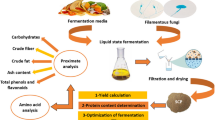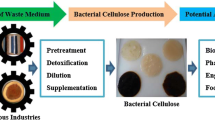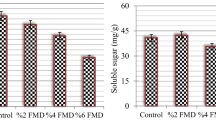Bacteria, yeast and filamentous fungi were isolated from various sites within a paper mill. Bacillus alvei and Aerobacter aerogenes were the most prevalent contaminating bacteria. Maximum slime was produced by A. aerogenes (4.2 mg ml−1) at pH 6.5 and by B. alvei (7.2 mg ml−1) at pH 7.5 in white water. The optimum temperature was 40°C for maximum slime production by both organisms. In the presence of levanase, a 25% reduction in dosages of a biocide (Bioplus®) was observed. Killing of A. aerogenes, which was achieved in 8 h with 20 ppm Bioplus®, could be obtained in 6 h with the combined use of levanase and a lower concentration of Bioplus® (15 ppm). With B. alvei almost the same inhibitory effect (4.22-log decrease) was obtained at 20 ppm Bioplus®, and in combination with a lower concentration of Bioplus® (15 ppm) and enzyme. The paper properties did not show any adverse effect after treatment with levanase and Bioplus®.
Similar content being viewed by others
Author information
Authors and Affiliations
Additional information
Received 21 March 1995/ Accepted in revised form 15 February 1997
Rights and permissions
About this article
Cite this article
Chaudhary, A., Gupta, L., Gupta, J. et al. Studies on slime-forming organisms of a paper mill—slime production and its control. J Ind Microbiol Biotech 18, 348–352 (1997). https://doi.org/10.1038/sj.jim.2900393
Issue Date:
DOI: https://doi.org/10.1038/sj.jim.2900393




